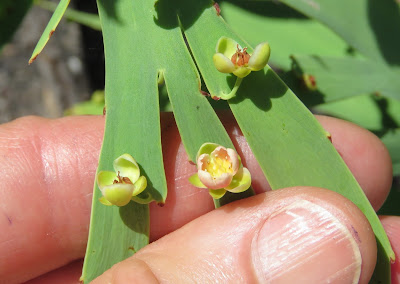Pretty, leafless, and not a guinea worth
The genus name Hibbertia honors George Hibbert, a lover of plants and patron of botany. George was a fellow of the Royal Society and the Linnean Society in London, and purchased collections of preserved plants (herbaria) as well as funding collecting trips to, for example, the Cape of Good Hope in southern Africa.
If we look at this particular species (Hibbertia dilatata, above) from the Top End of Australia and compare it to those more usually associated with the name George Hibbert, you'd be looking for leaves and perhaps more yellowish flowers. The one below is your more 'typical' Guinea Flower, from Ku-ring-gai National Park.
And this one from our front yard, Hibbertia stellaris, a native to Western Australia, stretches the yellow to orange, but at least it has leaves.
There are around 250 species of Hibbertia in the world, the vast majority found in Australia but with some in Madagascar, New Guinea, New Caledonia and Fiji. Northern Territory has 50 species, with 28 of these added as new in 2010 (by Helmut Toelken) and five moved across from what used to be called Pachynema, a mostly leafless groups of plants.
Flowers of the genus Hibbertia can be yellow, orange, pink, white or red, but many species do have yellow flowers - hence the common name, Guinea Flower. The flower from the Northern Territory has white to creamish petals, but more often flushed with pink. This flower has three remaining of the five petals. Still pretty, but not conjuring up a guinea.
Pachynema means thick filaments. Filaments are the stalks that hold the sacks of pollen aloft in a flower, and these flowers have ring of stumpy bottle-like filaments just inside the petals, as you can see here (in yellow).
As a gratuitous aside, this particular specimen was growing in a recently burnt area near Greenant Creek, in Litchfield National Park. The ants in question were nesting in the leaves of a nearby Red Paperbark (Lophostemon lactifluus); illustrated, with ants, below. You can bite their green bums off for a tangy treat.










Comments